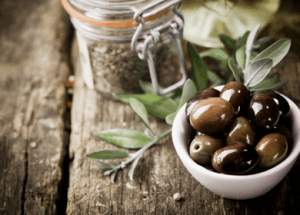
A popular food for thousands of years, olives pack a powerful nutritional punch along with their rich flavor.
 THE FOLKLORE
THE FOLKLORE
One of the oldest cultivated trees, the olive tree, along with its branches, fruit, and oil–permeates legend, history, and palates around the world. A universal symbol of peace, glory, and abundance, the olive, native to Asia Minor, was first cultivated in the Mediterranean during the fifth century BC.
According to mythology, Zeus promised to name the region of Attica that contained what would become the city of Athens for the god or goddess who brought the most useful invention. Poseidon brought a warhorse and Athena brought the olive tree, useful for heat, light, shade, food and medicine. Legend has it that the olive tree that grows at the Acropolis in Athens comes from those first roots.
THE FACTS
Olives are the fruit of the Olea europea tree. There are thousands of cultivars, but only a few are grown abundantly, both for olives and olive oil. A few important cultivars are arbequina, bosana, kalamata, manzanilla, and mission. Some olives may be eaten right from the tree, but most sold commercially are cured with water, brine, or lye.
Regardless of variety and processing, olives are high in healthy, cholesterol-lowering monounsaturated fats and are rich in many health-protective nutrients, including an array of antioxidants. A one-cup serving packs 22 percent DV (percent Daily Value, recommended intake for 2,000 calories/day) of iron, 16 percent DV for dietary fiber, and 20 percent DV for copper for 148 calories.
THE FINDINGS
Most of the olive’s fat is made up of oleic acid, a monounsaturated fat associated with reduced risk of heart disease. Olives are also plump with a diverse collection of phytonutrients, including polyphenols–known antioxidants which protect against cell damage.
A study published this year in the Journal of Alzheimer’s Disease found daily consumption of oil from olives as part of a Mediterranean style diet may protect against age-related cognitive decline or Alzheimer’s disease. A laboratory study published in a 2011 issue of the Journal of Agricultural Food Chemistry found that olive skins contain important antioxidants that inhibit breast cancer cell growth.
THE FINER POINTS
Whether canned, jarred, or in an olive bar, olives are fun to explore. Sample the variety of greens, blacks, reds, sizes and textures–smooth, wrinkled, or cracked. Some are even stuffed with peppers or nuts and swimming with herbs and spices. Olives make a simple snack or appetizer on their own, or blended with olive oil, garlic and seasonings as tapenade to spread on bread or top fish and poultry.
NOTABLE NUTRIENTS
Olives, 1 cup, ripe, canned
Calorie: 148
Dietary fiber: 4 grams (16 percent daily value)
Vitamin A: 315 IU (11 percent DV)
Vitamin E: 2 mg (10 percent DV)
Calcium: 133 mg (11 percent DV)
Copper: 4 mg (20 percent DV)
Iron: 4 mg (22 percent DV)
– Environmental Nutrition
Reprinted with permission from Environmental Nutrition, a monthly publication of Belvoir Media Group, LLC. 800-829-5384. www.EnvironmentalNutrition.com. (c) 2012 BELVOIR MEDIA GROUP DISTRIBUTED BY TRIBUNE MEDIA SERVICES, INC.

